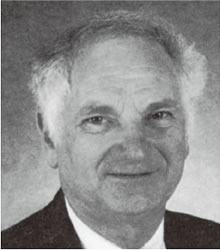1996年比較腫瘍学常陸宮賞受賞者
The Awardee of the 1996 Prince Hitachi Prize
for Comparative Oncology
"Studies on Tumors of Lower Animals"
下等動物の腫瘍に関する研究
 ジョン C. ハーシュバーガー博士
ジョン C. ハーシュバーガー博士
Professor John C. Harshbarger
ジョージワシントン大学メディカルセンター教授
Professor John C. Harshbarger
Professor, Department of Pathology
Director, Registry of Tumors in Lower Animals
The George Washington University Medical Center
研究業績
ジョン・C・ハーシュバーガー博士の下等動物の腫瘍の研究の進歩に対する優れた業績は以下の通りである。
ハーシュバーガー博士の最も優れた業績は下等動物腫瘍の登録センターというユニークな組織をつくられたことである。ここには、80カ国から集められた6300件の腫瘍が登録されており、内容的には変温脊椎動物のすべての綱と無脊椎動物の6つの門を含んでいる。このコレクションは、多くの同学の研究者の純粋な協力によっている。これらの腫瘍と関連文献は、比較腫瘍学、病理学、疫学、また、下等動物の研究のために公開され、広く研究と教育に利用されている。同博士は、多くの協力者、材料提供者と共に、1つ1つの腫瘍を丁寧に検索し正確に記載すると共に、腫瘍の発生と相関について新知見を報告し、腫瘍多発の疫学を研究され、さらに実験的研究を行って優れた成果を上げておられる。
同博士は、扁平動物門における最初にして唯一の腫瘍、フカに寄生しているトレマトーデスの神経芽細胞腫を報告している。また、変温脊椎動物のマスト細胞腫の報告もまた、最初にして唯一である。これはサンショオウオで発見したものである。現在は下等動物の松果体腫瘍に違いないと思われる難しい腫瘍、実験魚類の松果体芽腫を研究されている。
ハーシュバーガー博士と共同研究者は、多数の腫瘍多発群を研究し、水底に棲息する魚の中で15-20種に発生した肝癌が、水中における高濃度の多核芳香族炭化水素類(PAHs)および他の化学発癌物質と強く相関していることを発見された。この化学発癌物質と魚の肝癌の相関関係は実験でも確認された。このようなことから同博士は、自然の魚の肝癌の発生は、その魚の棲息している場所の発癌物質の存在を示すものであると確信をもって想定しておられる。
同博士のエリー湖に流れ込むブラックリバーのナマズの肝癌の研究は有名である。これは付近のコークス工場からの化学発癌物質(PAHs)の汚染によって、ナマズに高率に肝癌が発生したということが博士の長年の研究で明らかになったものである。米国議会はこれを重視して同博士にヒアリングを求め、工場は閉鎖された。5年後、PAHsレベルは川底泥からも、ナマズの組織からも急激に減少した。そして肝癌は75%減少し、ナマズの寿命が2年以上延びたのである。これは、癌の原因となると考えられる川の汚染をなくすことによって、流れが自然に回復したことを示す最初の証明である。かくて、浄化に要する費用を大幅に節約することができるであろう。
発癌実験の成果としては、ギンザケの骨腫瘍発生がある。これはサケの卵黄嚢に発癌物質MNNGを注入して発生させたものである。哺乳動物を用いた骨腫瘍の適当な実験モデルがほとんどないので、この魚モデルはこの種の研究に有用であると思われる。
直接に人間に関与するものとしては、抗酸化剤BHA(ブチル化ヒドロキシアニソール)の暴露による魚の肝臓の慢性炎症性の腫瘍様病変をつくったことがあげられる。もし癌の発生が確認されれば、米国のFDAは法によって食品添加物としてのBHAの使用禁止を義務づけるのである。
Academic Achievement
Dr. John C. Harshbarger's outstanding contributions to the advancement of research in tumors of lower animals are as follows.
Dr. Harshbarger's foremost achievement has been building the Registry's unique specimen collection to over 6300 accessions from 80 countries with neoplasms from all classes of cold-blooded vertebrates and from six invertebrate phyla. These neoplasms and the related literature serve as a widely used resource for research and education on comparative pathology, epidemiology and other aspects of lower animal tumors. This collection has been built with the cooperation of many selfless people. He has teamed up with quite a few of them to describe the tumors they have found, to report new records of tumor occurrences and associations, to study the epidemiology of tumor clusters, and to carry out experimental laboratory studies.
With his teams, he has reported the first and only neoplasm in the Phylum Platyhelminthes which was a neuroblastoma in a parasitic trematode from a shark. He reported the first and only mast cell tumors in cold-blooded vertebrates which were found in salamanders. Currently, he is studying what he believes is the only pineal body tumor in a lower animal--a probable pineoblastoma in an experimental fish.
He and his colleagues have studied numerous neoplasm clusters and have good data showing that liver cancer in 15-20 species of bottom-feeding fish is strongly associated with high concentrations of polynuclear aromatic hydrocarbons (PAHs) and other carcinogenic chemicals in the waterways. This association between chemical carcinogens and fish liver cancer has been confirmed in the laboratory with almost no false positives. He confidently postulates that the occurrence of liver cancer in wild fish indicates the presence of carcinogenic chemicals in their habitat.
His long-term study of liver cancer in catfish at a coking plant outfall near where the Black River empties into Lake Erie resulted in a Congressional hearing and the closing of the coking plant. Five years later the levels of PAHs in the river sediment and catfish tissue had plummeted. Liver cancer had dropped about 75% and catfish were living two years longer. This is the first demonstration of natural remediation in a stream after the pollution stops with cancer as the endpoint and it could greatly reduce cleanup costs.
An experimental achievement was the induction of bone tumors in coho salmon after MNNG was injected into the yolk sac. Since there are few, if any, good experimental mammalian models for bone tumors this fish model might be useful for such studies.
Directly affecting humans was his reinterpretation of tumor-like liver lesions as chronic inflammations in fish exposed to the antioxidant, butylated hydroxyanisole (BHA). If cancer had been confirmed, the U. S. Food and Drug Administration would have, by law, been obligated to ban BHA's use as a food additive.

